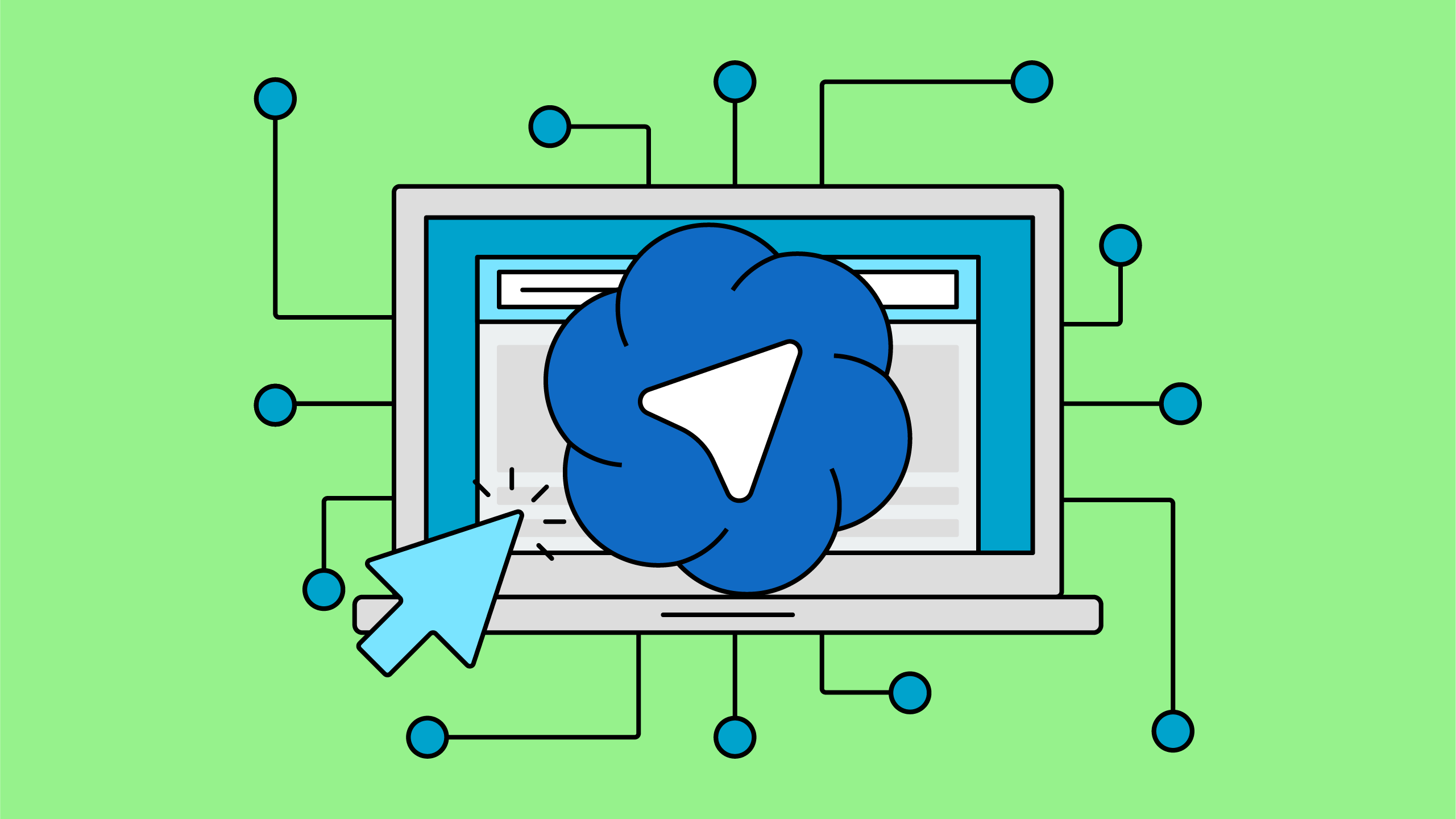2024 was a transformative year for digital marketers and our webinars were here to guide you through it all! From crafting measurement strategies and leveraging AI to building stronger communities, we covered practical and actionable insights that helped marketers stay ahead of the curve. If you missed a session or want a refresher, this recap is for you.
Crafting an effective measurement strategy with Jill Quick
Are your analytics working for you—or against you? Jill Quick unpacked the secrets to building reports people actually use and aligning data with real business goals.
1. Scope surveys are a must
Before jumping into dashboards, start with a scope survey. This helps you understand which metrics matter to different teams and what questions they need answers to. A scope survey can save you hours of work and align your analytics efforts with business priorities.
Ask these scope questions:
- What metrics do you care about the most?
- What data do you not trust, and why?
- What reports would help you make smarter decisions?
The goal is to gather input from all relevant stakeholders—not just the marketing team. You should be sending out scope surveys to a wide range of stakeholders, from marketing and sales teams to finance and CRO teams. This ensures you’re gathering insights that truly reflect the needs of your organization, reducing blind spots and aligning efforts across departments.
2. Design analytics reports that people actually use
No one wants to sift through endless tables of data. Jill encouraged marketers to adopt a “post-it note reporting” mindset—summarizing key insights in a format that’s easy for the intended audience to digest. Whether it’s creating high-level dashboards for executives or detailed reports for marketing teams, the goal is always to simplify and focus on what matters most.
📌 Tip: A great way to start? Wireframe your reports before diving into the actual tools. Jill shared how sketching out reports on paper (or in a basic mockup tool) helps clarify the story you want to tell with your data. Wireframing ensures the layout aligns with stakeholders’ needs and minimizes rework down the line.
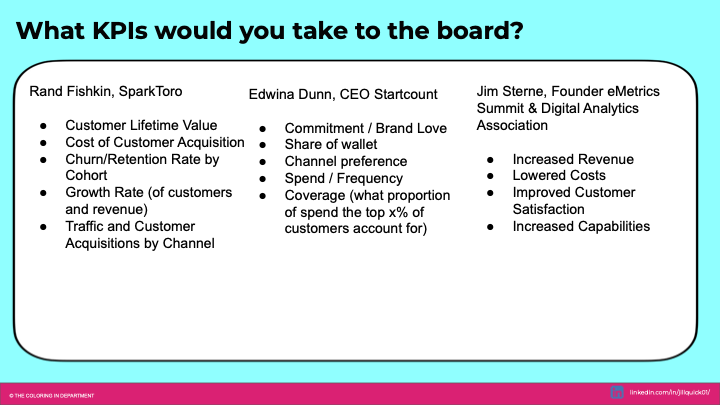
3. Map your website’s conversion points
Not every interaction on your website is created equal. Jill stressed the importance of event mapping—connecting business goals to specific on-site actions like form submissions, purchases, or video plays. This process gives you meaningful data instead of noise.
What to do:
- Identify your website’s “money pages”—the pages where conversions happen (e.g., product pages or lead forms).
- Create a list of actions (events) to track on each page, such as downloads, clicks, or form fills.
- Use GA4’s event mapping tools to track these interactions and tie them to your goals.
For eCommerce, track micro-conversions like “added to cart” and macro-conversions like “completed checkout” to understand your customer journey.
“What does the person looking at the report care about? What do people need to know in their specific roles and which performance metrics best represent that information?” – Jill Quick
AI-Powered insights from GA4 with Andy Crestodina
Andy Crestodina showed how to combine AI with marketing data to uncover smarter insights. From cleaning data to spotting content opportunities, his session was all about using AI to make better decisions.
1. Clean your data before feeding it into AI
No matter how smart AI is, it’s only as good as the data we feed it. If the data’s messy, the results will be too.
Before asking AI to analyze anything, ensure your data is structured and free of noise. For example, when exporting data from GA4, you might need to remove unnecessary rows, consolidate similar entries, or filter out irrelevant details like foreign language title tags.
📌 Tip: Always use the same chat for each specific analysis you are completing, only start a new chat if you are using unrelated data or want to do a new or different analysis.
2. Reports are just the start—use AI to drive real impact
Andy emphasized that while reports provide data, they don’t affect outcomes. The real value lies in analyzing those reports to uncover actionable insights that drive change.
Think of reports as a snapshot, not the story. AI tools like ChatGPT can help turn static data into strategies.
- Export Data from GA4: Start with reports that show critical metrics, like page views, sessions, or conversion rates. For example, filter blog posts by performance metrics such as engagement or conversions.
- Set a Clear Goal: Before diving in, decide what you’re trying to uncover—whether it’s content performance, underperforming keywords, or high-converting pages.
- Ask AI Targeted Questions: Instead of generic prompts, frame your queries to focus on actionable insights such as, “What content performs best by engagement and why?” or “Which pages drive conversions?”
- Verify Insights: Always cross-check AI’s suggestions.
3. Use AI to find and fill in the gaps
One standout method involved analyzing Google Search Console data with your GA4 data to identify content you’re missing or haven’t written yet. For example, by comparing top-performing pages and their associated queries, AI can pinpoint on-page SEO edits to improve rankings or identify content gaps.
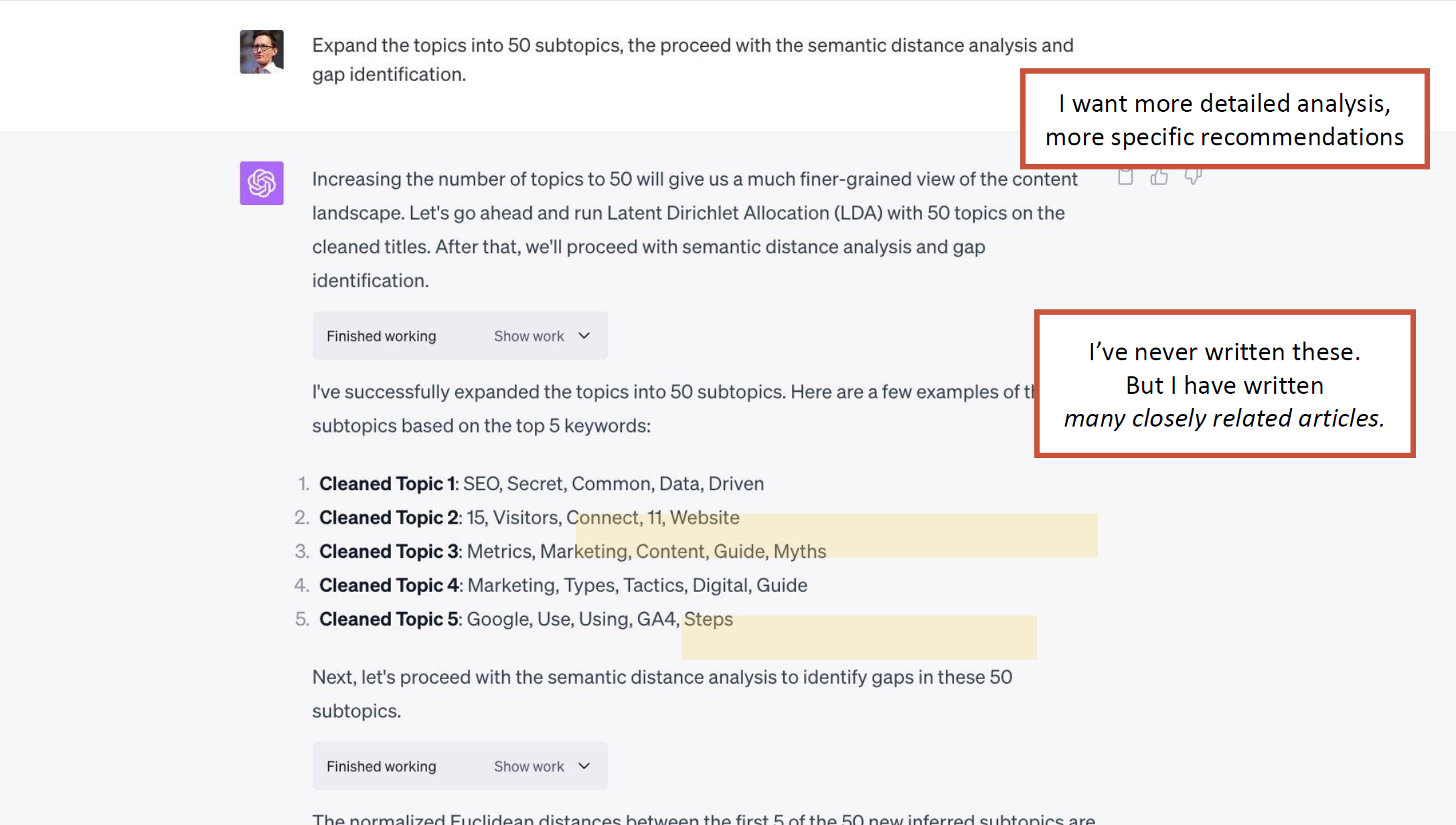
“I don’t need tons of data or perfectly accurate data because I’m only looking for clues. I only want data that’s accurate insofar as I can make a decision and take an action from it.” – Andy Crestodina
Stay in the loop of what's new in digital marketing
Your analytics questions answered with Dana DiTomaso
GA4 got you confused? Dana DiTomaso broke it all down, answering top questions and offering practical ways to make analytics clearer and more actionable.
1. Understanding scopes in GA4
Avoid scope mismatches by ensuring the right metrics align with the right data types. There are 4 scopes in GA4:
- User
- Session
- Event
- Item
A common mistake users make is misapplying session-scoped metrics to event-scoped metrics, which can lead to inaccurate data—often showing the metric average as zero. To avoid this, ensure the dimension has the highest scope and that the metrics used are appropriate for that scope.
🔖 This GA4 cheatsheet has a list of all the scopes of all the dimensions and metrics in GA4—bookmark it!
2. Standard vs exploration reports
Reports and explorations in GA4 often show discrepancies due to differences in how data is processed, aggregated, and filtered. Explorations allow for more customization but are limited by data retention settings.
While reports aggregate data into pre-configured categories, explorations offer flexibility for deeper analysis but may show incomplete data if retention settings aren’t updated to 14 months.
Always set data retention to 14 months in GA4’s admin settings to ensure consistency between reports and explorations.

3. Simplify client reporting with context and clarity
Dana highlighted the importance of presenting clients with digestible and actionable insights rather than overwhelming them with raw data. Using clients’ own words and focusing on their primary concerns—like “Is the phone ringing?”, helps bridge the gap between technical analytics and client priorities.
Dana shared how adding microcopy—short, clear explanations of metrics and charts—can make reports easier to understand, while also building trust by being transparent about successes and challenges.
📌 Tip: Before creating a report, ask yourself: What action should the client take after seeing this?
“Don’t create a report to try to hide, you know, something bad and be like, well, you know, this didn’t do as well as we wanted it to but I’m going to show this information instead. Don’t do that. I think being honest is one of the real hallmarks of what builds a really great client relationship.” – Dana DiTomas
Metrics that matter in local SEO with Claire Carlile
Local SEO can feel overwhelming, but Claire Carlile cut through the noise. She highlighted the metrics that actually drive results and shared how to make them work for your clients.
1. Client-centric reporting
Not every client wants (or needs) the same level of detail, your reporting should reflect what’s most relevant to the client, whether they’re a small business owner, a marketing team, or a large agency.
The three types of clients:
- “Do it for me” clients: Small business owners who just want to know how many calls, bookings, or dollars came from your work. Skip the fancy metrics and focus on outcomes.
- “Do it with me” clients: These clients, like small marketing teams, want insights into what’s working, what’s not, and some guidance on optimizing campaigns.
- “Teach me” clients: Agencies or larger organizations want everything—detailed reports, testing frameworks, and the why behind every decision.
Before creating a report, talk to your client, ask questions, understand the outcome they want, so you can drill down into what you need to measure (at this stage you should create a goal charter).
2. Track local SEO metrics that actually drive revenue
Metrics like phone calls, GBP clicks, and even driving directions are valuable, but context is key. Claire shared how pairing these data points with tools like GA4 and CallRail can uncover opportunities to optimize operations and drive growth.
Examples to try:
- Call Tracking: Use a tool like CallRail to monitor answered vs. missed calls. If most calls are unanswered during peak times, it’s a clear sign to adjust staffing.
- UTM Tagging: Tag all GBP links with UTM parameters to see exactly how much traffic and revenue your Google Business Profile is driving. (💡 Download our Guide to UTM Tracking in GA4—improve your attribution and prove your value to clients)
- Google Posts for Offers: One client increased sales by 63% by creating time-sensitive offers on GBP. Quick, easy, and effective.
📌 Tip: If you’re stuck trying to optimize non-branded queries, pull GSC data, filter for rankings in positions 4–15, and refine content to push into the top three.
3. Evolve with metrics, but stay grounded
Local SEO tools and metrics evolve constantly, especially with updates to GA4 and GBP. Claire stressed the importance of staying flexible and understanding the limitations of metrics.
Keep up by focusing on what drives results and learning to adapt:
- Use GA4’s path analysis to identify bottlenecks.
- Filter data in Google Search Console with regex to separate branded and non-branded queries.
- Pair GBP metrics with tools like CallRail for a fuller picture.
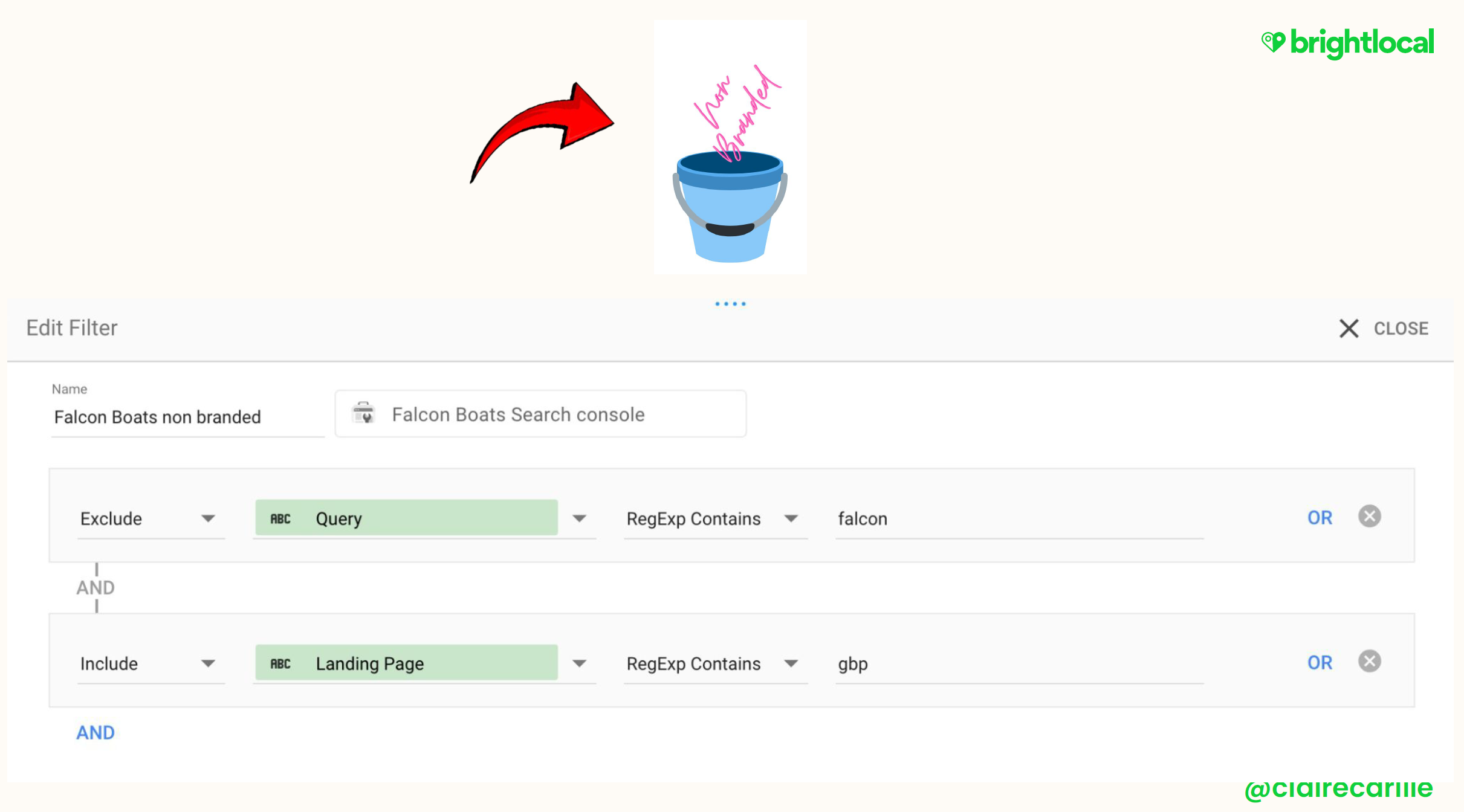
“Metrics come and metrics go. But we need to not blindly trust the metrics. We need to always interrogate the metrics. We need to upskill ourselves and make sure that we know how these tools are measuring these data points. Otherwise, we are not providing useful information for our clients and for stakeholders” – Claire Carlile
Content distribution in the AI era with Ross Simmonds
Ross Simmonds reminded us that content isn’t done once it’s published. His session focused on how to distribute your content smarter and maximize every piece you create.
1. Create once, distribute forever
The biggest mistake marketers make is creating content and letting it sit idle. Ross emphasized that content must be repurposed and shared across multiple channels to reach its full potential.
Think of your content as an asset, not a one-time project. Ross highlighted how Disney’s strategy—remastering, reimagining, and redistributing its classics—is a model marketers can emulate. A blog post can become a carousel on LinkedIn, a thread on X, a YouTube video, or a snippet in a newsletter. The goal is to maximize the reach of every piece.
2. Four E’s framework
Make sure each piece of content either Educates, Engages, Entertains, or Empowers. This makes your content memorable and more shareable.
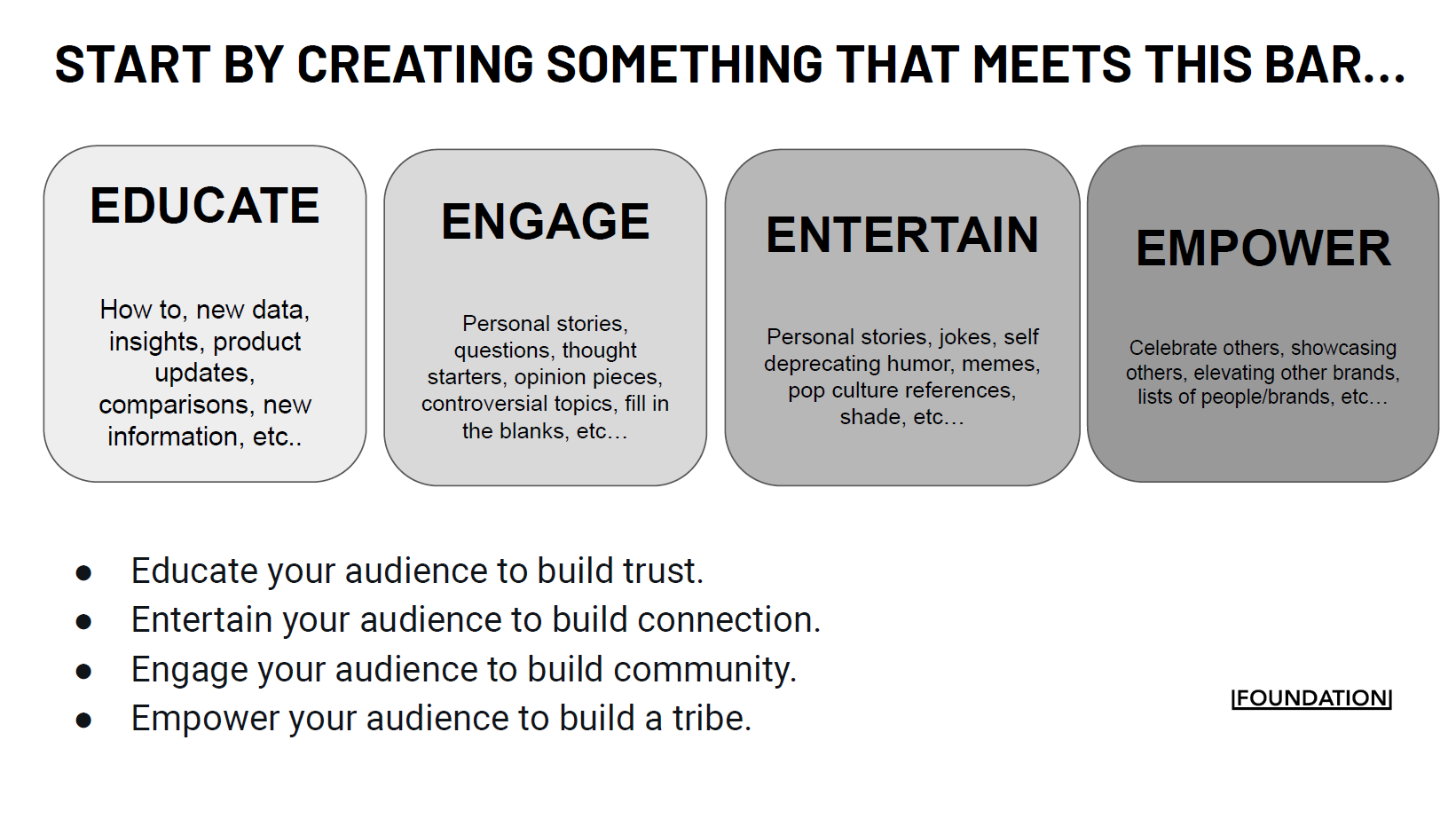
📌 Tip: Ask yourself, “Is this content solving a problem, sparking a conversation, making someone smile, or celebrating a community?”
3. Research where your audience spends time
Understanding your audience’s habits is crucial. Ross underlined the importance of finding out which platforms and communities your target audience frequents before committing resources to content creation or distribution.
Don’t just guess where your audience hangs out—use tools like Audiense and SparkToro to gather data on their interests, preferred platforms, and online behaviours. For instance, if your audience is highly active on Reddit, you can reverse-engineer the style and tone of top-performing posts in relevant subreddits.
“I believe we all have to recognize that it’s a new dawn. It’s a new day. The old strategy of just pressing publish on a whole bunch of blog posts and hoping that people find you is what I said when I had no facial hair and I had no idea about what was coming down the road.” – Ross Simmonds
Google Ads measurement for 2024 & beyond with Ginny Marvin
Ginny dove into how we need to adjust our ad strategies with all these privacy changes. First-party data, Enhanced Conversions—she made it clear what’s essential to stay competitive next year.
1. Prioritize first-party data
With third-party cookies fading and privacy regulations tightening, first-party data is no longer optional—it’s critical. First-party data allows for more durable and comprehensive measurement, ensuring your strategy stays adaptable as the digital landscape evolves. Whether it’s hashed emails, purchase history, or form submissions, this data allows you to accurately track conversions, model behaviours, and optimize ad bidding.
📌 Tip: To make the most of first-party data, start by implementing proper tagging infrastructure. Use Google Tag or Google Tag Manager to ensure sitewide tagging is in place, and implement consent mode for international audiences.
2. Optimize with enhanced conversions
Enhanced Conversions enable more accurate conversion tracking by sending hashed user data from your website to match conversions with ad clicks. The key? Completing the loop by integrating CRM data into Google Ads.
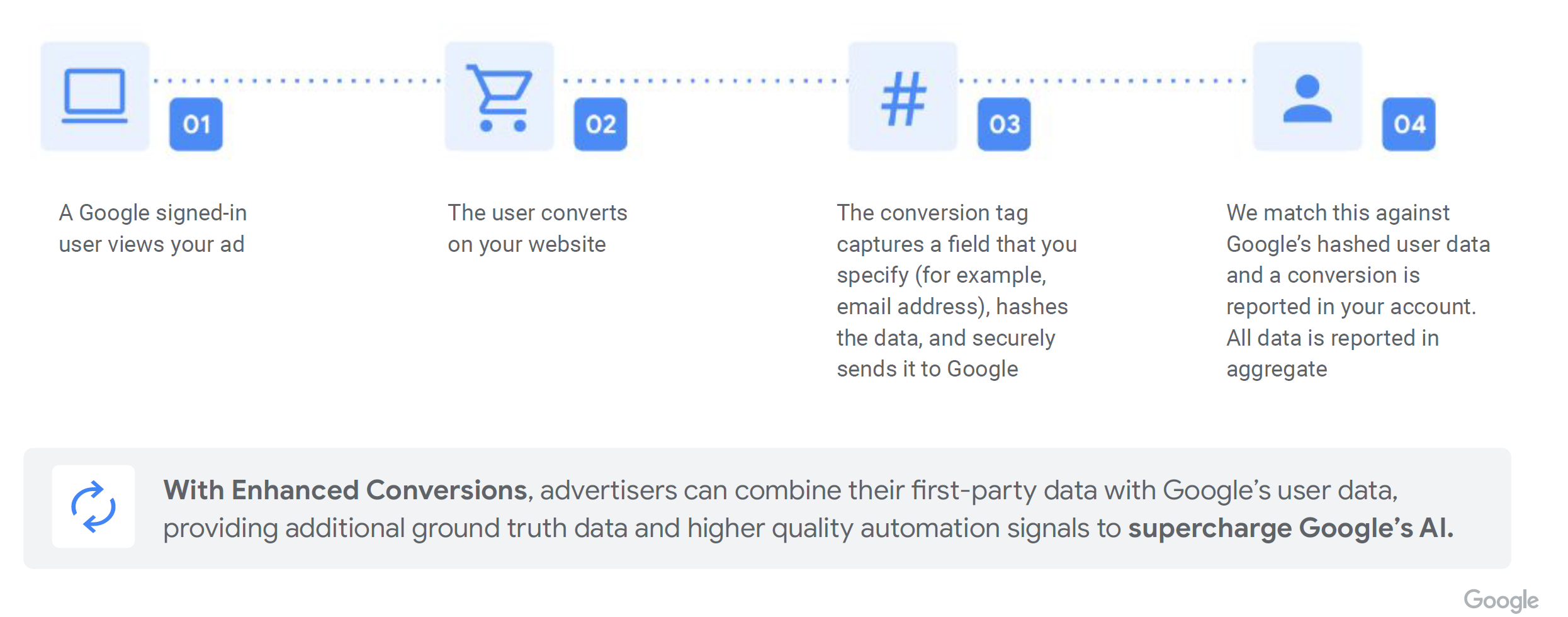
After capturing lead data, you need to send updates back to Google Ads when those leads convert into sales. Without this step, you miss out on key insights for optimizing your campaigns. Tools like Zapier make this process manageable for small businesses, even without a CRM.
3. Use diagnostics tools to improve tagging and measurement
Diagnostics tools in Google Ads can help you identify and fix tagging issues, ensuring your measurement setup is running at its best. Located in the “Goals” section of Google Ads, the Diagnostics tab flags gaps in tagging, such as missing tags on pages or inactive features.
These tools don’t just identify problems—they also provide actionable recommendations. For example, they may highlight opportunities to enable features like Enhanced Conversions or Conversion Lift Studies. Though some alerts can feel overly dramatic (e.g., tagging staging sites), they are designed to be thorough and prevent critical errors. Regularly checking these tools can help ensure your tagging infrastructure is sound and your measurement strategy stays on track.
“When you are asking users for their data, what is your value exchange, right? You need to be giving them something and making it worth their while. And so I think this probably is going to be…a time for all brands, all companies, all businesses of any size to be thinking about what that value exchange is with your customers, what you want that relationship to look like and investing in those kinds of programs.” – Ginny Marvin
Information Gain: Expanding topics to rank with Bernard Huang
In SEO, standing out is everything. Bernard Huang explained how to create content that adds value and ranks higher by covering fresh, engaging topics.
1. Expand content thoughtfully
Use information gain to focus on topics not yet widely covered to provide fresh, authoritative insights. Think of information gain as your way of telling Google, “I’m bringing something fresh to the table.”
For example, if every article on a topic discusses SEO fundamentals like backlinks and authority, your content needs to go further. Maybe you bring in perspectives on AI’s impact on SEO or new tools reshaping the industry. Google looks for diversity in content, rewarding pieces that enrich user experience with new angles or ideas.
2. Avoid redundant content
With the rise of AI-generated content, redundancy has become a major issue. Bernard emphasized that simply rephrasing existing content won’t cut it. Google uses entity recognition to detect semantic redundancy—content that repeats concepts without adding value.
Ask yourself: What’s missing in the current conversation? By weaving these into your content, you’re showing Google that your piece offers fresh, forward-thinking insights.
📌 Tip: Using tools like ClearScope or Google Natural Language Processing can help you identify the essential entities to include and areas to innovate.
3. Focus on user engagement
Content that ends a user’s search journey—by answering their query comprehensively—outperforms content that leaves users searching for more. Google tracks signals like time on page, clicks, and search exits to measure engagement and adjust rankings accordingly.
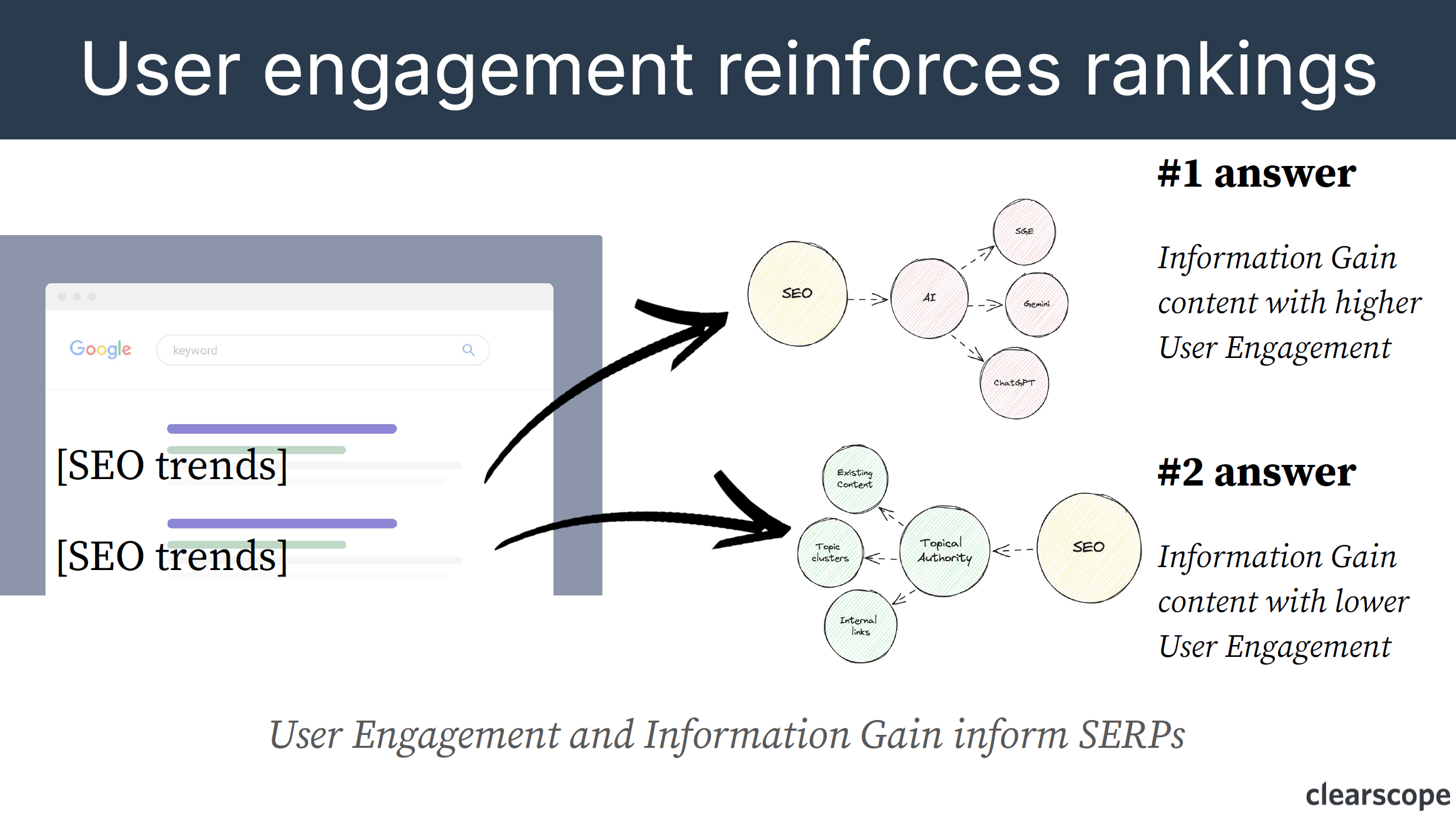
Bernard explained how adding a first-person case study or unique data can elevate a page’s authority and keep users engaged, even in competitive spaces like health or finance. Above all, ensure your content truly serves the user’s intent—not just the algorithm’s preferences.
“Information gain is the idea that when users browse the internet for any given topic, that they want to read more about what the topic is directionally heading towards, and that’s based off of course, what Google is going to be serving the user.” – Bernard Huang
Turning browsers into buyers with Aaron Weiche
Ever wonder why your site visitors leave without taking action? Aaron Weiche shared how to remove roadblocks and guide users to take action with tools like live chat, smarter calls-to-actions (CTAs), enhanced content, and proper lead management.
1. Reduce friction to increase conversions
The biggest barrier to conversions is making users work too hard. Every step on your website should clearly guide them toward their next action, eliminating guesswork and making their journey as frictionless as possible.
Aaron emphasized the importance of simplifying your website’s user experience, from intuitive navigation to concise, action-oriented CTAs. For instance, your CTA shouldn’t just say “Click Here.” It should be actionable and specific, like “Get Your Free Quote Today.”
2. Offer multiple engagement levels
Not every visitor is ready to commit right away, so it’s important to provide various levels of engagement based on where they are in their journey. For example:
- For those exploring options, low-commitment offers like newsletter sign-ups, social media follows, or free resources work well. Be clear about what they’ll get and how often.
- For more curious users, offer options like live chat, texting, or simple contact forms. Keep forms short and easy—collecting the minimum information necessary to start the conversation.
- For those who are ready to take action, use CTAs like “Request a Quote” or “Book a Call.” Make sure the process is straightforward, and consider tools like Calendly to streamline scheduling.
3. Respond quickly and build trust
The faster you respond to leads, the higher your chances of conversion. Aaron explained how response time can make or break a potential sale.
Conversion rates are 8x higher when you respond within five minutes. Why? Because speed builds trust. If you’re quick to reply, users assume you’ll also be attentive throughout their experience. He also noted that 78% of customers choose the first business to respond, so being fast can give you a major competitive edge.
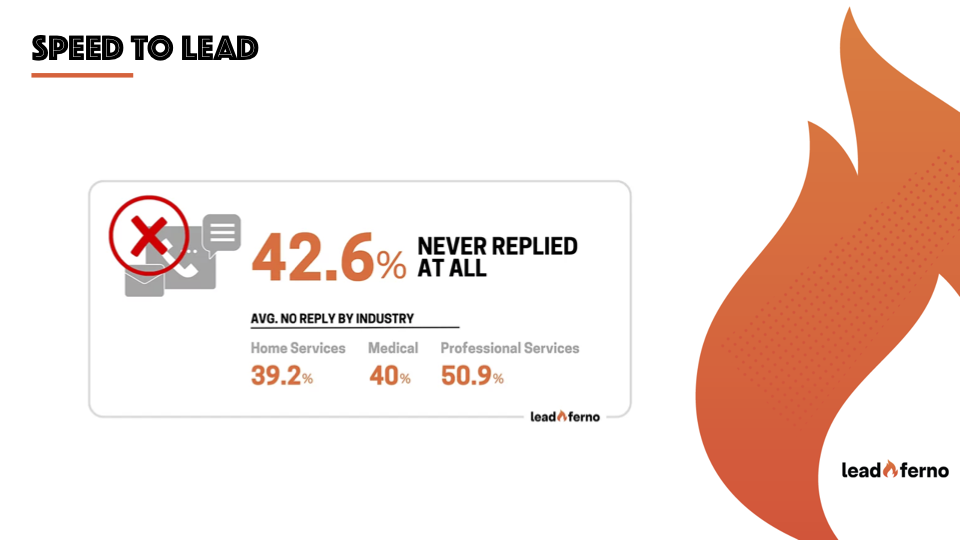
📌 Tip: Implement an auto-reply to acknowledge leads instantly. Whether it’s via email or text, a quick confirmation reassures users that you’ve received their inquiry.
“Are you easy to work with? We have endless choices. There’s endless competition. There’s endless results in any type of search that I do. And for me, nine times out of ten, I’m gonna go with the business that’s easiest to work with.” – Aaron Weiche
Building community for Growth with Erin Simmons
Erin Simmons dove into what it really means to build a community. Their session explored how connection and belonging are the foundation of successful marketing.
1. Community is about belonging, not broadcasting
True community isn’t built by shouting about your brand—it’s about creating spaces where people can feel a sense of belonging, safety, and support. Erin emphasized that belonging is a core human need, and successful communities meet this need by fostering connections and allowing members to be vulnerable.
The heart of any strong community is a shared purpose. Whether it’s a Slack group for professionals or a local hobby meetup, the focus should always be on building trust and providing meaningful support, not just attracting more members.
📌 Tip: Prioritize connection over promotion to create a community that people genuinely want to be part of.
2. Community-building requires ongoing care
Communities are not static; they require constant tending and adaptation. This includes listening to members’ needs, updating codes of conduct, and evolving values as the community grows.
Erin explained how Women in Tech SEO started as a small meetup but grew into a global community by listening to member feedback and expanding inclusivity. For example, they adapted their approach to include people of all marginalized genders, ensuring the space felt welcoming and safe for a broader audience.
3. Align monetization with community values
Erin emphasized that while monetizing a community is often necessary for sustainability, it must be done thoughtfully to ensure it aligns with the community’s core mission and values. Sponsorships and revenue streams should enhance the community’s purpose, not compromise it.
In Women in Tech SEO, monetization efforts, such as sponsorships and ticketed events, are carefully curated to maintain trust and inclusivity. Erin shared how they vet potential sponsors to ensure their values align with the community’s mission. If a partnership feels off or could detract from the community’s integrity, they aren’t afraid to walk away.
Monetization is about more than just sustaining the community financially—it’s about preserving its culture and delivering meaningful value to its members. By staying true to your values, you create a community that thrives both ethically and financially.
“Communities can never stay static. Like, it’s always going to be changing. You don’t just start a community and, like, walk away, right? Like, it always needs tending, it always needs evolution, it always needs changing.” – Erin Simmons
Looking forward to 2025
As 2024 wraps up, one thing stands out: success comes from being intentional—whether it’s how we use data, build communities, or engage with audiences. This year’s insights focused on creating real value and driving action through thoughtful strategies.
In 2025, we’ll continue exploring smarter approaches to marketing and staying ahead of industry changes. Stay connected by subscribing to our newsletter, where we’ll continue to share the latest trends, expert advice, and actionable strategies to help you grow.


